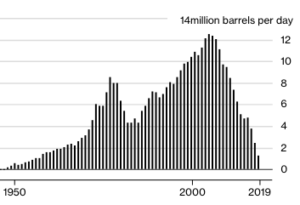Has American “Energy Independence” Finally Arrived?
December 17, 2018 - 2 minutes readNews wires were abuzz last week with the announcement that the US had become a net oil exporter for the first time in nearly 75 years. This is major news, but does it truly mark a milestone toward the country’s goal of energy independence? And is the claim even true in the first place?

US net imports of crude oil and refined petroleum products. (Courtesy Michael Lynch, US EIA, Bloomberg)
The answer to both of these questions is a definite maybe. The story is based on data found in the Energy Information Administration’s (EIA’s) Weekly Petroleum Status Report, which tracks and publishes stats on US oil production, consumption, exports and inventories. The EIA stats have shown a dramatic uptick in domestic oil production for some time, thanks to the so-called “shale boom” from the Permian to the Bakken to the Marcellus. But for the week in question (ending Nov 30th), the US produced 11.7 million bpd of crude, which is roughly 8 million bpd less than it consumes. This suggests that energy independence is not as close as some might think.
A thorough analysis by Robert Rapier for Forbes shows that counting oil alone doesn’t support the net exporter claim. But, if one counts our export of other products in addition to crude—things like NGLs, ethanol, and finished products—then we did indeed export about 0.2 million bpd more hydrocarbons than we imported.
So, while last week’s news is an impressive achievement and we’re heading in the right direction, we still have a fair way to go become net exporters of crude and to achieve anything resembling energy independence.
Count on EnergyMakers Advisory Group to keep you up-to-date on oil and gas developments like this.
Tags: Hydrocarbon production, United States